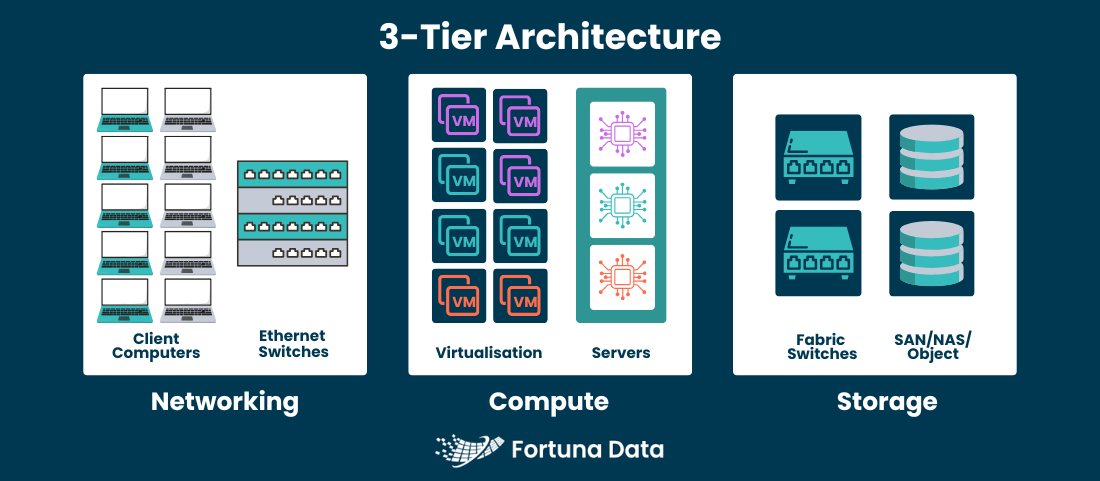Menu
For the past 30+ years global organisations have been deploying a 3-tier architecture. It is easy to install, manage and expand comprising of three primary components servers, storage and lastly a network fabric.
In the beginning an organisation bought servers then loaded an operating system, connected your storage whether that was local, a NAS or a SAN and then the server connected to your network infrastructure.
Next came the advent of more powerful processors with multiple cores, this created the hypervisor and led to virtualisation appearing. Now operating systems could be segregated and the available server resources shared by creating VMs (virtual machines) on a single server.
The 3-tier architecture allows for the easy expansion of additional server, storage or networking with little or no disruption to infrastructure and this is why it has changed because it’s straightforward and simple.
Understanding 3 tier architecture is essential for developers, project managers, and IT professionals alike. By breaking down an application's structure into manageable parts, teams can enhance scalability, maintainability, and performance. Whether you're building web apps or enterprise systems, grasping this concept will help streamline your processes.

Using a 3-tier architecture offers several advantages that can enhance an organisation’s IT framework. One significant benefit is scalability. As businesses grow, this architecture allows for easy addition of resources without disrupting existing systems.
Another advantage is improved maintainability. Each layer operates independently, making it simpler to update or modify one part without affecting the others. This separation also promotes better organisation and clarity in development processes.
However, there are drawbacks to consider as well. Complexity can be a challenge; managing three distinct layers requires careful planning and skilled personnel. Organisations may face increased costs due to the need for more infrastructure and support staff.
Performance issues might arise if communication between tiers isn’t optimised effectively, leading to latency problems. Balancing these pros and cons is essential when deciding whether to adopt a 3-tier architecture in your projects or initiatives.
Implementing a 3-tier architecture in your organisation begins with assessing your current system. Identify the existing components that need separation into three distinct layers: Servers ensuring that they are more than capable of handling the multiple VMs that you will be running. Data Storage that can handle multiple IOPS so the users or data are not affected by performance bottlenecks and finally the network, this is purely down to preference and this could be iSCSI, Fibre Channel, Ethernet or FCoE.
Training staff is crucial for success. Educate them about their roles within this architecture framework to enhance productivity and send them on training courses so that they fully understand their roles.
Conduct thorough testing at every stage of development to identify any weaknesses or bottlenecks before going live. Regular updates will also keep your system performing optimally over time.
Implementing a 3-tier architecture comes with its share of challenges. One common issue is the complexity of managing communication between the tiers. As your application grows, ensuring seamless interaction can become tricky.
Scalability also poses difficulties. With increasing user loads, you may encounter performance bottlenecks that hinder responsiveness and efficiency. This could lead to a poor user experience if not addressed promptly.
Security is another concern. Each layer requires distinct security measures to protect sensitive data from potential breaches or unauthorised access.
To mitigate these issues, adopting microservices can enhance modularity and streamline interactions between components. Implementing load balancers helps distribute traffic effectively across servers, improving scalability.
Regular security audits are essential for identifying vulnerabilities early on. By maintaining strong authentication protocols and encryption methods throughout all layers, you enhance overall system integrity while reducing risks significantly.
Another essential part of running a 3-tier architecture is administering patches and updates as they could be an issue as an incorrectly administered patch or update fails leading to system downtime.
Understanding and utilising 3-tier architecture is essential for modern organisations aiming to improve their software development processes. This architectural approach offers a clear separation of concerns, making it easier to manage complex systems.
Embracing 3-tier architecture equips organisations with the tools necessary to provide access to applications and server resources. As technology rapidly evolves, understanding this framework becomes increasingly vital in ensuring a robust infrastructure capable of supporting future growth.